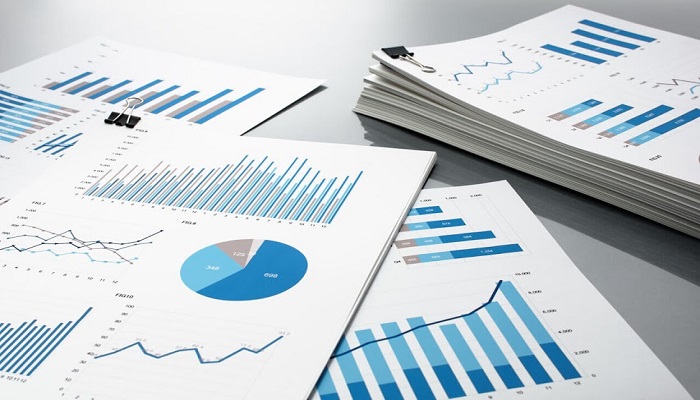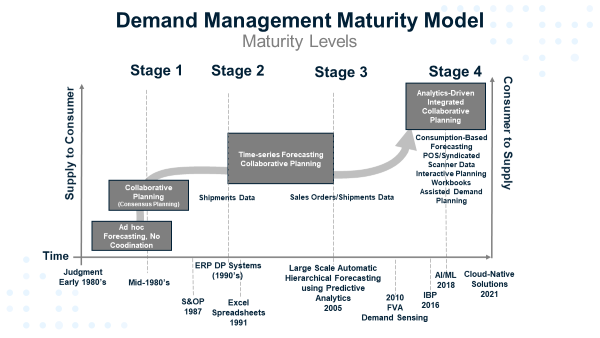Demand management concepts are now over 30 years old. The first use of the term "demand management" surfaced in the commercial sector in the late 1980s and early 1990s. Before that, the focus was on a more siloed approach to demand forecasting and planning that was manual and used simple statistical techniques, like moving averages and simple exponential smoothing, and then Excel, and a whole lot of “gut feeling” decision making. Sound familiar?
 In the mid-1990s, demand planning and supply planning were lumped together, giving birth to two supply chain management concepts: demand planning and integrated supply chain planning.
In the mid-1990s, demand planning and supply planning were lumped together, giving birth to two supply chain management concepts: demand planning and integrated supply chain planning.
Essentially, nothing has changed over the last 30 years -- other than organizations placing more focus on planning supply (shipments), using inventory buffer stock to manage the variation in the supply plan, and increased collaboration. There's been very little, if any, focus on advanced analytics and downstream consumption data.
Pandemic challenges
Worldwide challenges due to the coronavirus pandemic have exposed unforeseen gaps in retail and consumer goods companies' ability to effectively predict and plan demand as consumers rapidly shift their buying patterns. These companies must be able to react seamlessly in real-time to manage unforeseen demand disruptions. Although the industry has responded rapidly to shore up supply chains and alter operations on the fly to ensure product is where it needs to be, when it needs to be there, it requires making costly changes to meet consumer exceptions. As the industry has entered recovery mode, more mature retailers and consumer goods companies invested in their analytic capabilities with increased vigor to ensure a seamless transition from basic analytics to more consumer-centric, data-driven predictive analytics. Leaders are realizing the importance of investing in today to guarantee they are prepared for tomorrow.
The demand management journey
Companies have been on the demand management journey since the late 1980s (see Figure 1), but have continued to rely on outdated demand planning practices. They use historical shipment data and simple statistical time series methods deployed by their ERP (Enterprise Resource Planning) systems, along with Excel spreadsheets, to back into a constrained demand plan, which isn’t a demand plan at all: It’s actually a constrained supply (shipment) plan. This consensus-driven planning process is labor-intensive, requiring hundreds of manual overrides before it reaches supply planning for final execution by manufacturing and distribution.
This traditional approach to demand forecasting established in the 1990’s is unable to capture many of today’s complex market dynamics and is plagued with bias, human error, waste and inefficiencies. As a result, demand planners are unable to capture market dynamics, including price changes and promotions, as well as changing demand patterns and external factors related to the pandemic.
 Over the course of the last 30 years, companies have moved from Stage 1 in the maturity model to Stage 2. Several are trying to move to Stage 3, and only a handful of companies are approaching Stage 4, utilizing downstream data and implementing consumption-based forecasting and planning. Most companies are stuck in Stage 2 and are doubling down even after experiencing the past 18 months of unforeseen disruptions.
Over the course of the last 30 years, companies have moved from Stage 1 in the maturity model to Stage 2. Several are trying to move to Stage 3, and only a handful of companies are approaching Stage 4, utilizing downstream data and implementing consumption-based forecasting and planning. Most companies are stuck in Stage 2 and are doubling down even after experiencing the past 18 months of unforeseen disruptions.
Table 1 describes the requirements for each stage in the demand management maturity model. Those companies who are emerging as leaders in demand management (DM) have mastered Stage 3 and are moving quickly to Stage 4. Those same leaders are transitioning to an analytics-driven culture investing in new cloud-native demand management technologies, data scientists, predictive analytics and machine learning.

Why change now?
Companies are experiencing unprecedented complexity as they look for growth and market opportunities. Their product portfolios are growing with new product introductions, new approaches for existing products and new sales channels. The emerging endless aisles of the internet and mobile shopping channels are expanding product offerings, adding unparalleled supply chain complexity and making it difficult to manage inventory effectively. Sales and trade promotion spending, designed to grow sales revenue, continues at a staggering pace.
The goal is to improve decisions regarding product distribution and operations across all channels of the business. As direct customer relationships are influenced by mobile devices and in-store IoT, these new data streams are introducing new sources of insights. However, it’s taking time to transition from limited analytics to a more expansive role. Companies are quickly realizing that their enterprise effort requires a completely different culture that includes different skills, processes, analytics and technology. Although many companies have already started to collect data across all their distribution channels to gain more customer and consumer information, the race to apply analytics to optimize sales and inventory across all channels has taken much more effort than anticipated.
Predicting demand and managing inventory across every channel is hard work. Shorter product lifecycles, expanding assortments, frequent price changes and sales promotions compound the challenges companies are experiencing. It’s enough to make you wish you had an “easy button" to figure out today’s savvy shoppers and navigate through the four pandemic stages (preliminary, outbreak, stabilization and recovery) and demand shifts.
With the right demand forecasting and planning process, analytics and technology, you can simplify your demand planning process and create an integrated planning framework that supports multiple forecasting methods with one synchronized view of demand for every type of customer and consumer ship-to combination.
To learn more about about the 4 Stages of the Demand Management Maturity Model: Interactive guide how to build a road map to reach your optimal future state or read the free first chapter of my latest book Consumption-Based Forecasting & Planning: Predicting Changing Demand Patterns in the New Digital Economy.

